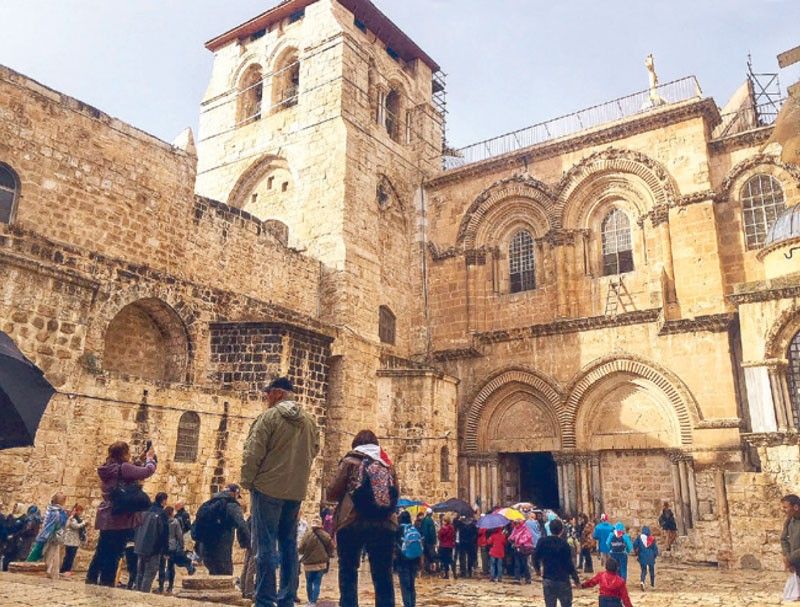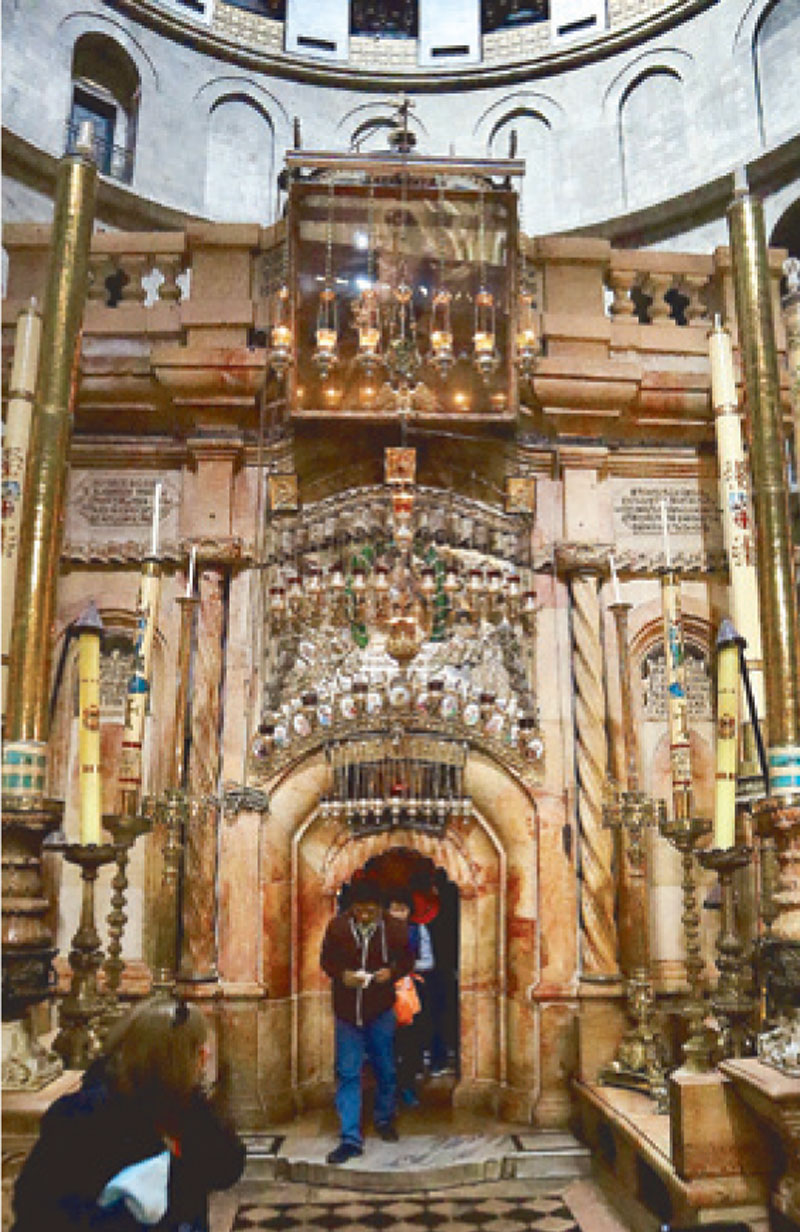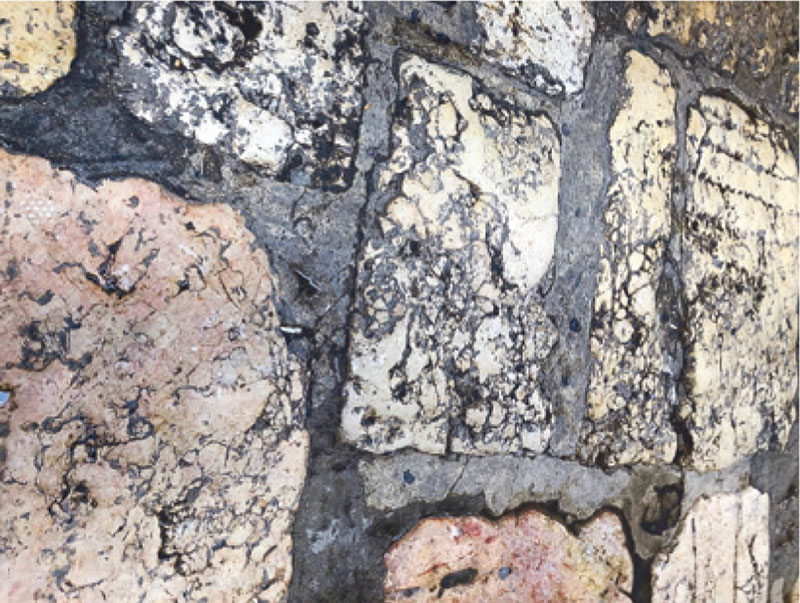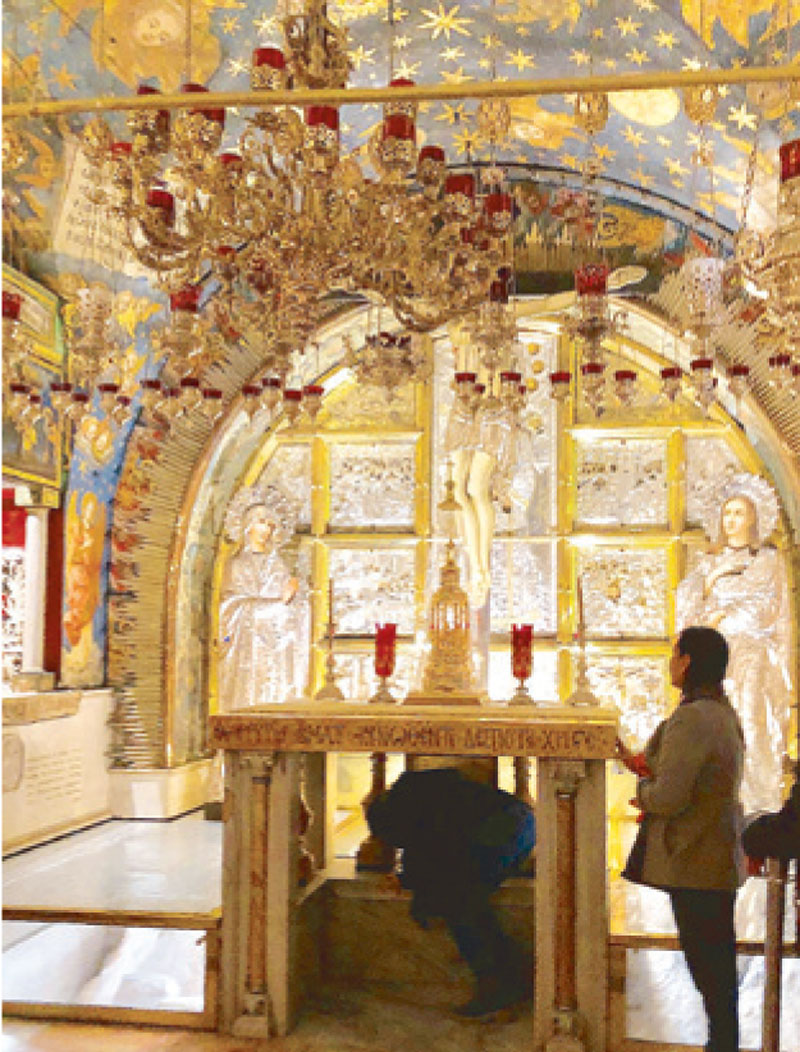Trip to Jerusalem

“Jesus said: ‘I am the resurrection and the life. The one who believes in me will live, even though they die; and whoever lives by believing in me will never die. Do you believe this’?” — John 11:25-26
Who would have thought that a childhood game could be such an adult blessing?
To most of us, “Trip to Jerusalem” is a parlor game also known as “musical chairs.” In the game, players compete for a limited number of chairs by circling them, and after the music stops playing, the one who gets the last chair is the winner.
A real trip to Jerusalem has no losers, for in this city that is the seat of three of the world’s major faiths (Christianity, Islam and Judaism), a pilgrim is certain to find his own chair, his own “moment,” his own place in the sun. For most visitors, each trip culminates in a personal victory, or victories for that matter.

The façade of the edicule inside which is the tomb of Christ, the holiest spot in Christendom. Photo by FERDIE CASTILLO
Most Christian pilgrims to Jerusalem get a spiritual high when they witness the depths of Christ’s suffering and realize how it led to the glory of our redemption.
Mahatma Gandhi has been quoted as saying, “A man who was completely innocent, offered himself as a sacrifice for the good of others, including his enemies, and became the ransom of the world. It was a perfect act.”
I was recently invited by Catholic Travel Inc. to join a pilgrimage to the Holy Land to retrace the footsteps of Christ in the only land he walked on. From Manila, we took a 12 1/2-hour flight via Turkish Airlines to Istanbul and from Istanbul, it was a two-hour flight to Tel Aviv. From Tel Aviv, Jerusalem is about an hour away by car.
As we enter the holiest of seasons in Christendom, let me take you on a trip to Jerusalem. Here is the conclusion of some of the highlights of my trip to Jerusalem:
4. The Via Dolorosa — Pilgrims should not expect the Via Dolorosa or the Way of the Cross as they see it in the movies. Most of the stations are now somewhere in a busy marketplace in Jerusalem, where one must “imagine the unimaginable.”
Perhaps, what has remained from the time of Christ are the ancient stones he walked on, mute witnesses to his agony. The first station (where Jesus was condemned) is now inside a school; the fourth station (Jesus meets his mother) is now a restaurant. The second station (Jesus takes up the cross) is a chapel, as are the third, fifth, sixth and seventh. Others are markers outside churches, not all Catholic.

The old stones dating back to the time of Christ. Photo by JOANNE RAE RAMIREZ
But when in prayer, it is not hard to reflect on Christ’s suffering on each station of the cross, especially since the road to Calvary is uphill and winding. With a cross on his severely scourged body, it was certainly an agonizing death march for Christ.
5. The Basilica of the Holy Sepulchre — The last five stations of the cross are in the Basilica of the Holy Sepulchre, whose custody is shared by different Christian denominations. Despite that, the basilica resonates with spiritual significance.
The 11th station (Jesus is nailed to the cross before his mother) is now a Roman Catholic chapel filled with intricate mosaics. Right beside it is a Greek Orthodox chapel that marks the spot where Jesus is believed to have died on the cross (the 12th station). The altar here is flanked by two supporting pillars. Underneath the altar is a silver disk with a fist-size hole in the center. This spot marks the exact place where Jesus’ cross stood on the rock of Golgotha or Calvary.

Underneath the dome of the Basilica is the edicule in which lies the tomb of Christ. Photo by JOANNE RAE RAMIREZ
When you put your hand into the hole and reach out about five inches, you can feel the rock where Christ’s cross stood. I rubbed my handkerchief and my rosary on this spot, for though physical relics of Christ’s crucifixion are not prerequisites to a strong faith, they are to me palpable manifestations of faith. I’ve always believed that to see and feel are to believe even more deeply.
The 13th station (Jesus is taken down from the cross) is more accessible to pilgrims. An altar marks the spot where Mary received the body of her son after he was taken down from the cross. Jesus’ body was then laid out on the Stone of Unction and anointed with a mixture of myrrh, aloe and aromatic oils.
The 14th station (Jesus is placed in the tomb) is on a spot that is the holiest place in Christendom. Last February, it took at least an hour for us to line up for a chance, nay, the privilege, to pray before Jesus’ tomb.

Underneath this altar is the rock where Jesus’ cross stood. Photo by JOANNE RAE RAMIREZ
The tomb of Jesus is in the center of the basilica beneath the main rotunda. It is within an ornate “edicule,” which resembles a mausoleum. Before you reach the tomb inside a small inner room, you will see a piece of the stone that was used to seal the cave where Jesus was laid to rest.
The sacred cave — hewn in stone — where Jesus was buried is now covered with a flat marble slab. That slab was put in place in 1555, or five centuries ago. Only five people at a time are allowed to pray before the tomb, over which you may gently rub your rosaries and crucifixes.
Words will not do justice to how I felt as I knelt before Jesus’ tomb. Overwhelming. Uplifting. Edifying.
I left Jerusalem with a faith lift.
- Latest






























